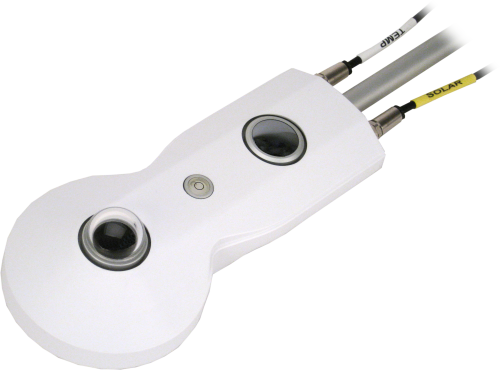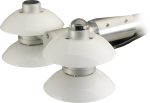
4分量研究级辐射表,内置热敏电阻和PT-100铂电阻






概览
CNR4为研究级的净辐射表,用于测量入射辐射能量与出射辐射能量之间的能量平衡。我们的数据采集器可以测量CNR4的这些输出。CNR4为科研级的能量平衡研究提供了专业的解决方案。
优势与特点
- Research-grade performance
- Meniscus dome on upper long-wave detector allows water droplets to easily roll off of it and increases field of view to nearly 180°
- Internal temperature sensors provide temperature compensation of measurements
- Drying cartridge helps keep the electronics dry
- Compatible with the CNF4 ventilation unit with heater that reduces formation of dew and melts frost
- Separate outputs of short-wave and long-wave infrared radiation for better accuracy and more thorough quality assurance
- Solar shield reduces thermal effects on the sensors
图像



技术说明
在结构上,CNR4含有一对朝上的短波辐射表和长波辐射表,以及镜像对称的一对朝下的短波辐射表和长波辐射。短波表和长波表分别测量短波辐射和远红外辐射。4个探头单独校准,具有各自的灵敏度系数。
CNR4的上部长波检测器含有新月形穹顶,使得水滴可以轻松的滚落。穹顶形状还增加了视野到接近 180° 而不是 150° 。
CNR4既含有内置的热敏电阻,也含有一个铂电阻,用于测量辐射表内部温度;通常使用热敏电阻测量内部温度,如果使用CR3000或CR5000,也可使用PT-100进行温度测量。
CNR4含有遮光盖用于减小对短波测量和长波测量的热效应。干燥剂筒让辐射表的电子部件保持干燥。可选的CNF4带加热通风单元,可以安装到CNR4,最小化露水的生成,以及除霜。
产品规格
| Sensor | Two thermopile pyranometers, two pyrgeometers, Pt100 RTD, and thermistor |
| Measurement Description | Measures incoming and outgoing short-wave and long-wave radiation |
| Response Time | < 18 s |
| Temperature Dependence of Sensitivity | < 4% (-10° to +40°C) |
| Sensitivity | 5 to 20 μV W-1 m2 |
| Non-Linearity | < 1% |
| Tilt Error | < 1% |
| Directional Error |
< 20 W m-2 (pyranometer) Angles up to 80° with 1000 W/m2 beam radiation |
| Operating Temperature Range | -40° to +80°C |
| Compliance | Conforms to the CE guideline 89/336/EEC 73/23/EEC. |
| Height | 6.6 cm (2.6 in.) dome-to-dome |
| Width | 11.1 cm (4.4 in.) |
| Length |
|
| Weight | 850 g (30.0 oz) without cable |
Pyranometer |
|
| Spectral Range | 305 to 2800 nm |
| Uncertainty in Daily Total | < 5% (The uncertainty values are for a 95% confidence level.) |
| Output Range | 0 to 15 mV (The output range is typical for atmospheric applications.) |
Pyrgeometer |
|
| Spectral Range | 4500 to 42,000 nm |
| Uncertainty in Daily Total | < 10% (The uncertainty values are for a 95% confidence level.) |
| Output Range | ±5 mV (The output range is typical for atmospheric applications.) |
兼容性
Please note: The following shows notable compatibility information. It is not a comprehensive list of all compatible products.
Additional Compatibility Information
Mounting
To avoid shading or reflections and to promote spatial averaging, the CNR4 should be mounted at least 1.5 m above the ground or crop canopy and away from all obstructions or reflective surfaces that might adversely affect the measurement.
The CNR4 can be attached to a vertical pipe or horizontal crossarm. To do this, first connect the radiometer to its mounting rod. The mounting rod then attaches to the pipe or crossarm via the 26120 Net Radiation Sensor Mounting Kit. The kit includes adjustment screws for leveling the CNR4. The 26120 can withstand winds up to 120 mph.
Data Logger Considerations
Four differential channels or four single-ended channels are used to measure the radiation components. A voltage excitation channel and an additional single-ended channel are required to measure the thermistor. If the RTD is used to provide the temperature compensation measurement, a current excitation channel (only available on the CR3000 and CR5000) and a differential channel are required.
相关技术文档
说明书
下载
CR1000X CNR4 Program Controlling the CNF4 Heater/Ventilator v.1 (4 KB) 17-10-2019
CR1000X program measures the CNR4 and controls the CNF4 heater/ventilator based on environmental conditions, and monitors the CNF4 tachometer. The program uses an EE181 temperature and relative humidity sensor and a 03002 Wind Sentry to provide the measurements for determining when to turn the fan and heater on and off. An A21REL-12 relay switches power to the CNF4.
CR1000X CNR4 Program using Thermistor v.1 (2 KB) 17-10-2019
CR1000X program that uses differential terminals to measure the four radiation outputs and one excitation terminal and one single-ended terminal to measure the thermistor. The program measures the sensors every 1 second, performs the online processing of the data, and stores processed data to a data table called cnr4_data once every 60 minutes. It also stores the raw time-series data from CNR4 to data table called cnr4_ts.
CR3000 CNR4 Program using Pt-100 v.1 (2 KB) 17-10-2019
CR3000 program measures the Pt-100 sensor for the body temperature of the CNR4. This program requires four differential channels to measure the four radiation outputs, one current excitation channel, and one differential channel for Pt-100 measurement. It measures the sensors every 1 second, performs the online processing of the data, and stores the processed data to a data table called cnr4_data once every 60 minutes. It also stores the raw time-series data from CNR4 to data table called cnr4_ts.
常见问题解答
CNR4-L: 8
展开全部收起全部
-
Yes. The signal from this sensor is not great enough to compensate for its dissipation because of the cable length.
-
As a general guide, go at least 1.5 m above the tallest plant (tree) in an ecosystem.
-
Only one 4WPB100 is needed to measure the internal PRT in the radiometer.
-
As of June 2013, all of our current and retired net radiation sensors can be mounted using this kit. These include:
- Current sensors: CNR4-L, NR-LITE2-L, and NR01-L
- Retired sensors: CNR1, CNR1-L, CNR2-L, NR-LITE-L, and Q7.1-L
-
Mount the net radiometer so that no shadow will be cast on it at any time of day from obstructions such as trees, buildings, the mast, or the structure on which it is mounted.
Campbell Scientific recommends installing a net radiometer in an open area, away from the main weather station structure on a separate vertical mast. If it is necessary to install this sensor on the main tall tower (30 ft or taller), the sensor should be installed at the top of the tower. In the northern hemisphere, the sensor should be facing south. In the southern hemisphere, the sensor should be facing north. If the tower uses a solar power system (that is, solar panels), ensure that the solar panels are installed away from the main tower.
-
Because of the loss of IR radiation, nearly all thermopile instruments typically have a negative offset. This offset is most easily visible at night-time, when a small negative value is read instead of zero. This same offset is present during the daytime, but it is not as visible because of the large solar signal.
Another common issue involves leveling an instrument. Leveling a thermopile instrument can cause errors in the direct beam component because the cosine response is not correct. These errors are more notable when the sun is close to the horizon because the angle is so shallow.
-
Technically, because albedo is the fraction of the sun’s radiation reflected from a surface, albedo cannot be quantified at night.
When calculating albedo, it is important to remember that when radiation readings are very low, there is a significantly large error associated with the ratio. For example, as the sun drops to a lower position on the horizon, the ratio of reflected and incoming radiation becomes somewhat meaningless.
Albedo can be calculated from the simultaneous incoming and reflected pyranometer readings, with the average stored. Both of these pyranometer signals should be in a differential input mode.
- At night-time, the upper pyranometer faces a cold sky, which causes the domes to cool and the readings to be negative. (For example, there may be readings of -2 to -7 W/m2, depending on the sky conditions.)
- In contrast, the lower pyranometer faces the ground, which could be warmer or cooler. The readings are unlikely to be positive, and may even be -2 W/m2.
In principle, two negative values could result in a night-time albedo of 0.5.
Because of the input resolution, noise, and offsets of the data logger used, it is highly unlikely that any individual pyranometer reading is exactly zero. Depending upon the configuration used, any positive irradiation values recorded by the data logger as less than 2 W/m2 may, actually, be less than zero.
If an upper pyranometer reading, a lower pyranometer reading, or both is/are less than 2 W/m2, the albedo value should be described as “undefined” or “invalid.”
Another approach is to just not calculate albedo when the flux values get small. For example, set a cut-off point for the minimum flux value that will be used in albedo calculations.
If solar position is being calculated, one other approach is to use a solar position calculation, such as 1° above the horizon.
-
If there is direct sun, the daily albedo graph is a U shape, because it’s a function of sun angle. If it’s a cloudy day without any direct sun, the daily albedo graph is more flat.
案例研究
This case study discusses the integration of CPEC310 and AP200 systems to explore the theories......阅读更多
Scientists and land-use managers have long recognized the importance of forest lands for their role......阅读更多




